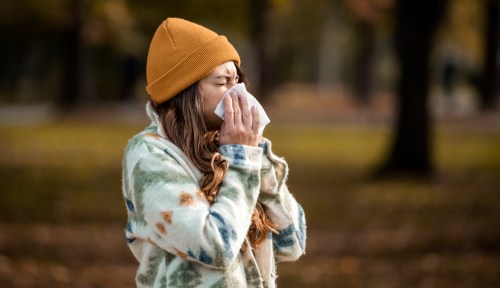Our editors independently select these products. Making a purchase through our links may earn Well+Good a commission
If there’s one season associated with allergies, it’s typically spring, with its abundant buds and blooms. But if you suffer from seasonal allergies, cooler weather and changing leaves don’t necessarily mean you can put away the tissue box. Fall also brings its own share of allergies. While symptoms are similar to those of springtime allergies—nasal congestion, sneezing, and watery eyes—there are differences between the two, says Clifford Bassett, MD, a board-certified allergist at the Asthma & Allergy Center of New York, and author of The New Allergy Solution.
Experts in This Article
board-certified allergist at the Asthma &
What causes fall allergies?
Quick science lesson: Allergies happen when our immune system reacts to a substance (like pollen or pet dander) as though it’s dangerous, and forms antibodies to attack it, even if it’s not actually harmful to us.
Tree pollen is the major source of spring allergies, but in the fall, about 50 million Americans are affected by ragweed pollen. Mold spores that increase in leaves and humidity are also a culprit, adds Dr. Bassett. One key to controlling these kinds of fall allergies is to reduce your exposure to pollen: Dr. Bassett suggests monitoring pollen counts in your area, closing windows when counts are high, and spending less time outdoors on dry, windy days.
But the reality is that many fall allergens are actually lurking inside. “As temperatures drop, patients tend to close windows and spend more time indoors, leading to greater exposure to indoor allergens including dust mites, animal dander, and cockroach particles,” he says. Mold and indoor chemicals can also send our antibodies into overdrive.
“Indoor air quality has a significant impact on allergy symptoms, especially since we spend 90 percent of our time indoors,” says Dr. Bassett.
The most effective route to clean indoor air
Dr. Bassett is an advocate of using air purifiers to help create cleaner air inside the home, thus minimizing allergy flare ups. “This is an invaluable strategy that I have found to be extremely helpful for many of our patients with multiple allergic sensitivities who suffer from seasonal, year-round allergies and other respiratory conditions,” he says.
It’s particularly important to find an air purifier with HEPA filtration to remove tiny airborne allergen particles that float throughout the air, says Dr. Bassett. He likes Rabbit Air, a brand with products that are Certified Asthma & Allergy Friendly by the Asthma and Allergy Foundation of America and Allergy Standards Limited.
If (like me) you’re not overly familiar with the world of air filters, Rabbit Air’s star product is the A3 Ultra Quiet Air Purifier (starting at $750), which has air quality sensors that adjust output when the unit’s in auto mode. “Technical factors affecting performance include the size of the room, clean air delivery rate, room ventilation, and other factors. Brands like Rabbit Air optimize for these criteria,” Dr. Bassett explains. This purifier is also customizable with the choice of either a Germ Defense, Pet Allergy, Odor Remover, or Toxin Absorber filter, which you can adjust depending on your particular triggers.
5 other ways to minimize indoor allergens
Along with using a high-quality air filter, creating a healthy home environment is essential to minimizing indoor allergy triggers that hit in the fall—or any other time of year, says Dr. Bassett. His top tips:
- Wash bedding weekly in hot water, and use allergen-proof mattress and pillow covers.
- Remove carpets that trap pet dander and other allergens.
- Run a dehumidifier to discourage mold growth.
- Clean up clutter that collects dust.
- Use a HEPA vacuum.
See an allergist to figure out your triggers
If you suffer from seasonal allergies, Dr. Bassett advises getting a jump-start on symptoms by starting medications and taking proactive steps to reduce triggers several weeks before the start of allergy season. If your symptoms are bothersome or long-lasting, he also recommends seeing an allergist, because while medications can provide relief, they can also have side effects and don’t address the root cause.
“Identifying your specific allergen triggers through testing allows you to take proactive steps to minimize exposure. For example, if you are allergic to dust mites, you can encase your mattresses and pillows, wash your bedding weekly, reduce humidity, and vacuum often,” says Dr. Bassett. “Avoiding triggers is more effective for long-term allergy management than just treating symptoms as they arise.”
Sign Up for Our Daily Newsletter
Get all the latest in wellness, trends, food, fitness, beauty, and more delivered right to your inbox.
Got it, you've been added to our email list.











